8 Evidence-Based Prevention and Treatment Models
Introduction
Substance use and often contribute to health related issues such as disease, injury, addiction, overdose and death and are seen as a public health concern. These issues affect individuals and communities collectively: psychologically, physically, socially, and economically. According to the Office of National Drug Policy (2013), misuse is costly to society and in the year of 2007 alone, the estimated economic cost was $193 billion. This cost included almost $120 billion in lost worker productivity (i.e., less workers available due to time away for treatment, incarceration or death), $11 billion in health care costs, and $61 billion in criminal justice costs. Given the large burden that substance misuse places on society, it seems prudent to prevent and address these problems before they occur.
Learning Objectives
- Define and understand terms related to evidence-based substance use prevention and treatment programs.
- Understand the principles of substance use prevention programs.
- Define and discuss effective treatment models for substance use disorders.
Image 8.1 – Collection of Road Signs
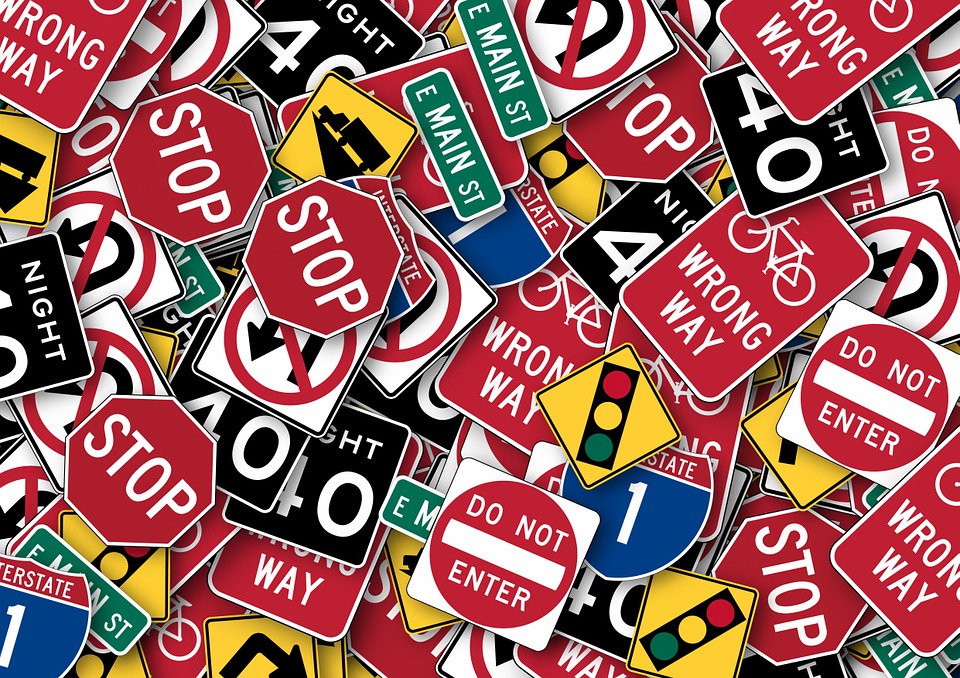
Learning Content
Image 8.2 – Deaths Related to Falling, Guns, Traffic Accidents and Drug Overdoses
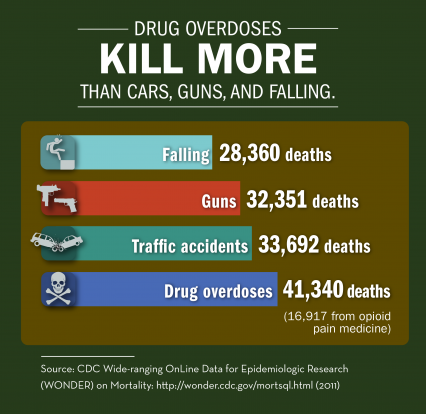
Substance misuse is among some of the most costly health problems in the United States. The National Institutes of Health looked at national estimates for the cost of illness for 33 diseases and conditions and found that of the conditions reviewed, alcohol ranked second, tobacco ranked sixth, and drug related disorders ranked seventh. (NIH, 2000). These statistics indicate that programs designed to prevent substance use and misuse are necessary and can help reduce these costs to society.
Image 8.3 – Stack of Hundred Dollar Bills

Substance Misuse and the Cost to Society
- More than $120 billion per year is lost in worker productivity
- Unemployment, reduced labor participation due to: incarceration, premature mortality, hospitalization, and time away from work for treatment programs
- Crime
- Deaths from overdose
- Domestic abuse and divorce
- Effects on unborn children
- Homelessness
- Spread of HIV/AIDS and Hepatitis C, etc.
Prevention
Research has shown that early onset of drug use increases one’s chance of becoming addicted (NIDA, Preventing drug use among children and adolescents, 2020). Therefore, the goal of substance misuse programs is to prevent, delay or limit the initiation of drug use and the associated negative consequences. Prevention activities set out to support individuals and the community through health promotion, health education initiatives aimed at preventing the misuse of drugs, preventing the development of substance use disorders and reducing the overall prevalence of drug use (SAMHSA, 2020). While many types of prevention programs exist, currently, there is no consensus on the best models to use to accomplish this goal.
Most prevention programs take a two-pronged approach:
- Reduce supply: decreased availability of substances reduces opportunities for misuse and .
- Reduce demand: increased health promotion and health education activities around substance misuse decreases the desire to engage in high-risk substance using behavior.
The goal of substance use prevention programs is to change behaviors that encourage substance misuse and to reinforce the positive behaviors and attitudes that discourage or prevent misuse.
SAMHSA Prevention Framework
The Substance Abuse and Mental Health Services Administration (SAMHSA), a branch of the U.S. Department of Health and Human Services (2019), has created a Strategic Prevention Framework.
The Strategic Prevention Framework is made up of five steps guided by two principles. The steps include:
- assessment: Collect data to determine the local population needs, resources, and gaps.
- capacity: Mobilize and/or build up resources to address prevention needs.
- planning: Development of a comprehensive plan.
- implementation: Carry out the plan, using evidence-based prevention programs.
- evaluation: Monitor the implementation, measure impact, and determine necessary improvements.
Additionally, it is important to remain mindful of the framework’s two overarching goals and to integrate them into each of the five steps. The goals include:
- sustainability: The capacity of a community to produce and maintain positive prevention outcomes after initial funding ends, over time, and while also consistently maintaining desired long-term results.
- cultural competence: The ability of an individual or an organization to interact effectively with members of diverse population groups.
The SAMHSA framework suggests that prevention efforts should be culturally responsive, meaning that these efforts should be adaptable and relate respectfully to other cultures, and that these efforts should be able to be sustained over time. According to SAMHSA, a program is considered successful after the completion of each step while also remaining aware and integrating both guiding principles (2019).
As substance use and misuse both have a large effect on society as a whole, strategies for prevention programs should focus not only on the individual but should also include population-based interventions.
Critical Thinking
Given what you know so far about substance misuse, why do you think someone might use or misuse substances such as tobacco, alcohol, or other drugs?
Risk and Protective Factors
Factors associated with greater potential or vulnerability to use substances are called “risk factors” while factors associated with reduced potential to use substances are called “protective factors” (NIDA, Preventing drug use among children and adolescents, 2020). These factors have been used to help identify those individuals who might be more likely to misuse substances. Effective prevention programs work to reduce risk factors and increase protective factors. Both risk and protective factors exist across multiple domains, therefore, prevention programs to address this issue should also cross multiple levels.
Social-Ecological Model of Substance Use
The social-ecological model demonstrates how people exist within and are shaped by their individual characteristics, families, friends and other relationships, their communities, and society. The overlapping rings illustrate how factors at one level influence factors at other levels.
Image 8.4 – SAMHSA’s Strategic Prevention Framework

If we dive even deeper into the social-ecological model we can see how these four levels−individual, relationship, community, and society−relate to and affect one’s experience with substance use. Let’s take a look at each domain individually.
Image 8.5 – Silhouettes of Many People
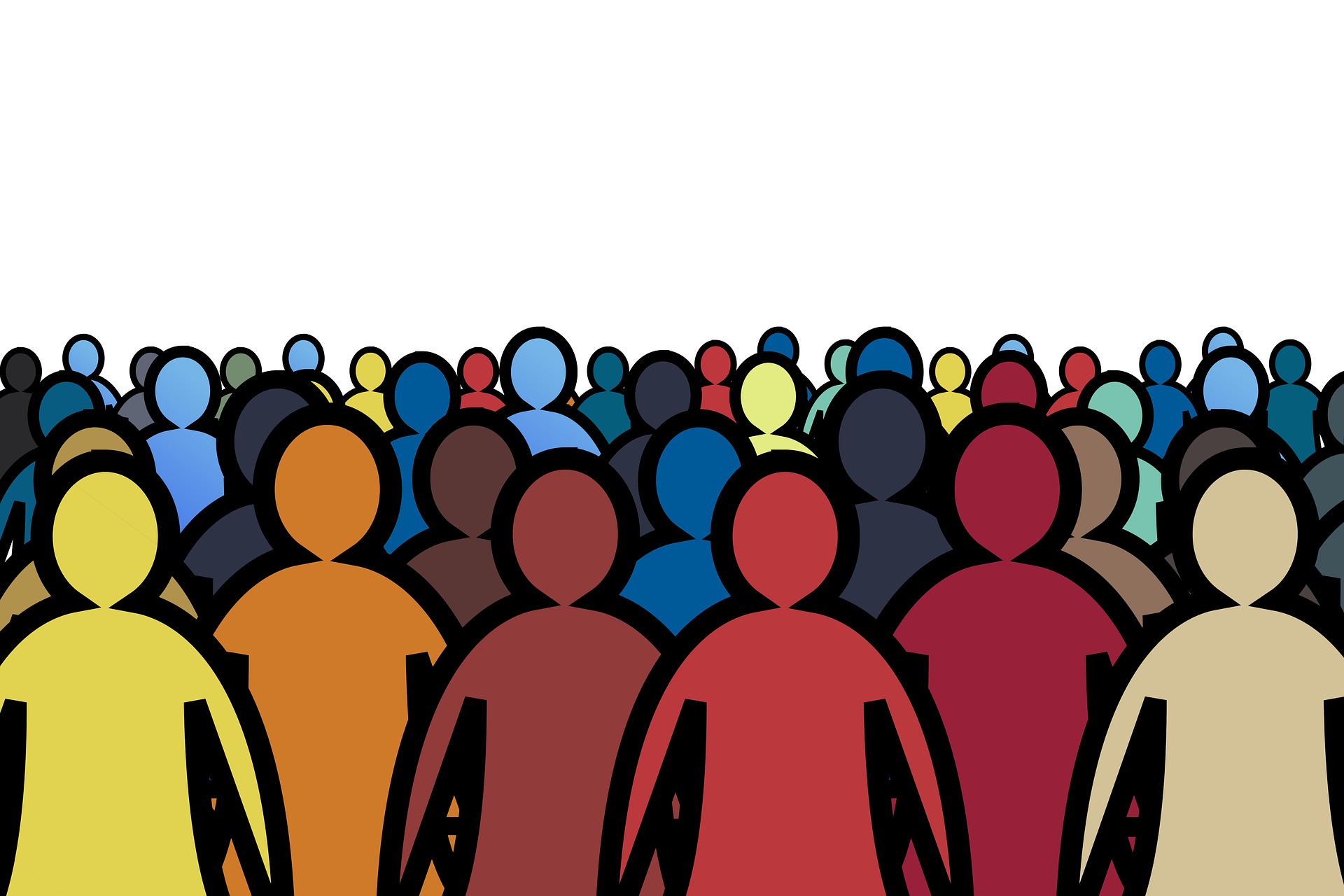
Individual (self): perception of risk; self-concept, age; knowledge; attitudes; problem solving skills; mental and physical health; trauma; resilience; developmental history
Interpersonal (family, friends and peer groups, social groups): family history; access to drugs; access to peer and family support; peer group use; social support systems; secure family-child relationships
Community: access to culturally responsive providers and health care services; health promotion and education campaigns; harm-reduction programming; implementation of evidence-based practices
Society: legislation supporting social service and recovery programs; policies that promote racial and health equity; food and housing security; health insurance coverage for mental-health and substance-use treatment; laws and policies on the local, state and national levels
The most effective and successful prevention programs focus on multiple levels including the individual’s personal beliefs (individual level), their relationship with their family and their peers (relationship level), and on the characteristics of society as a whole (community and societal level). Many risk and protective factors exist in each of these levels in regards to substance misuse.
Check Your Knowledge
Image 8.6 – D.A.R.E. to Resist Drugs and Violence
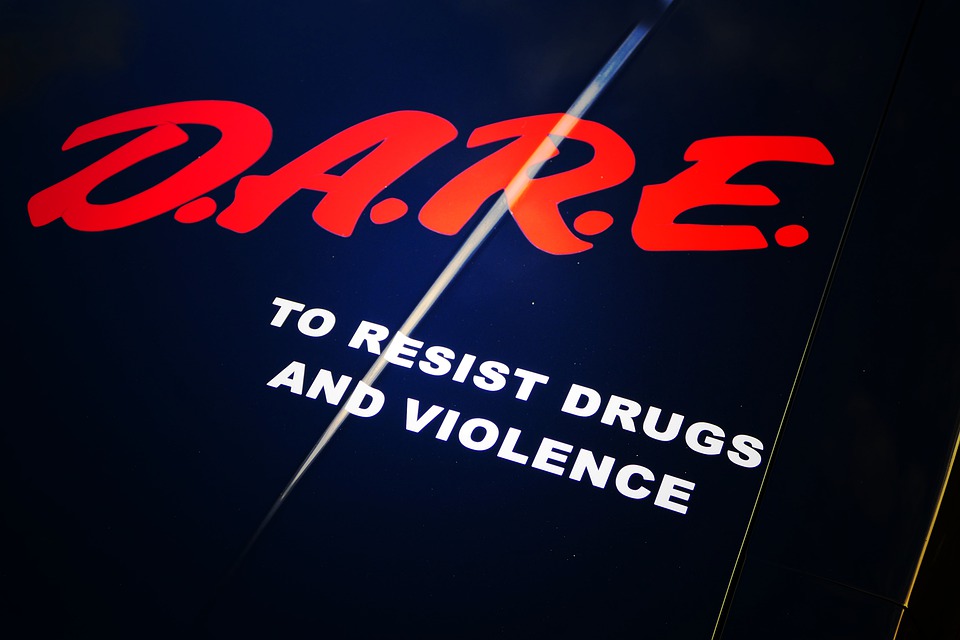
School-Based Programs
A number of factors have been identified that work to either protect adolescents or put them at greater risk for drug use and other high-risk behaviors. These factors are related to issues of community, school, family, peer and friend group dynamics, and individual characteristics. Historically, most school-based programs, such as the Drug Abuse Resistance Education program (D.A.R.E.) have produced disappointing results when evaluated for effectiveness (Botvin, 1986). Additionally, a study conducted by the University of Illinois at Chicago found that the D.A.R.E. program was “counter-productive and the students who participated in the program were more likely to use drugs” (Landmark Recovery, 2020). Recent studies have seen progress and better results for school-based interventions. Given that in the year 2005 alone, 80% of students reported participating in some type of school-based prevention program, it is necessary to look further into these programs to determine the most effective methods for engaging this population. There are several current programs that the National Institute for Drug Abuse (NIDA) lists for use with school-aged children:
Caring School Community Program, formerly known as the Child Development Project): This is a universal family-plus-school program to reduce risk and strengthen protective factors among elementary school children. The program focuses on strengthening students’ “sense of community,” or connection, to school. Research has shown that this sense of community has been key to reducing drug use, violence, and mental health problems, while promoting academic motivation and achievement.
Guiding Good Choices (GGC), formerly known as Preparing for the Drug-Free Years: This curriculum was designed to educate parents on how to reduce risk factors and strengthen bonding in their families. In five 2-hour sessions, parents are taught skills on family involvement and interaction; setting clear expectations, monitoring behavior, and maintaining discipline; and other family management and bonding approaches.
Life Skills Training (LST) Program: LST, a universal program for middle school students, addresses a wide range of risk and protective factors by teaching personal, social, and drug resistance skills. Universal programs address risk and protective factors common to all children in a given setting, such as a school or community (NIDA, 2020). In addition, an elementary school version was recently developed, and the LST booster program for high school students helps to retain the gains of the middle school program.
Lions-Quest Skills for Adolescence (SFA): SFA is a commercially available, universal, life skills education program for middle school students in use in schools nationwide. The focus is on teaching skills for building self-esteem and personal responsibility, communication, decision-making, resisting social influences and asserting rights, and increasing drug use knowledge and consequences.
Project ALERT: A 2-year, universal program for middle school students, Project ALERT is designed to reduce the onset and regular use of drugs among youth. It focuses on preventing the use of alcohol, tobacco, marijuana, and inhalants. Project ALERT Plus, an enhanced version, also includes a high school component, which is being tested in 45 rural communities.
Project STAR: Project STAR is a comprehensive, drug misuse prevention, community program to be used by schools, parents, community organizations, the media, and health policymakers. The middle-school portion focuses on social influence and is included in classroom instruction by trained teachers over a 2-year timetable. The parent program helps parents work with children on homework, learn family communication skills, and get involved in community action.
Skills, Opportunity, And Recognition (SOAR), formerly known as the Seattle Social Development Program: This universal, school-based intervention for grades 1through 6seeks to reduce childhood risks for delinquency and drug misuse by enhancing protective factors. The multi-component intervention combines training for teachers, parents, and children during the elementary grades to promote children’s bonding to school, positive school behavior, and academic achievement.
The Strengthening Families Program: For Parents and Youth 10–14 (SFP 10–14), formerly known as the Iowa Strengthening Families Program): This universal evidence-based program offers seven 2-hour sessions, each attended by youth and their parents, and is designed to help families to have better communication skills, teach skills about how to resist peer pressure, and prevent teen substance misuse. It has been conducted through partnerships that include state university researchers, cooperative extension staff, local schools, and other community organizations.
Given the amount of time that youth spend in schools, these institutions are vital avenues that can provide primary prevention education on the dangers of substance misuse.
Levels of Prevention
Prevention activities are typically categorized into three tiers:
Image 8.7 – Primary Prevention−Education; Secondary Prevention−Intervention; Tertiary Prevention−Treatment
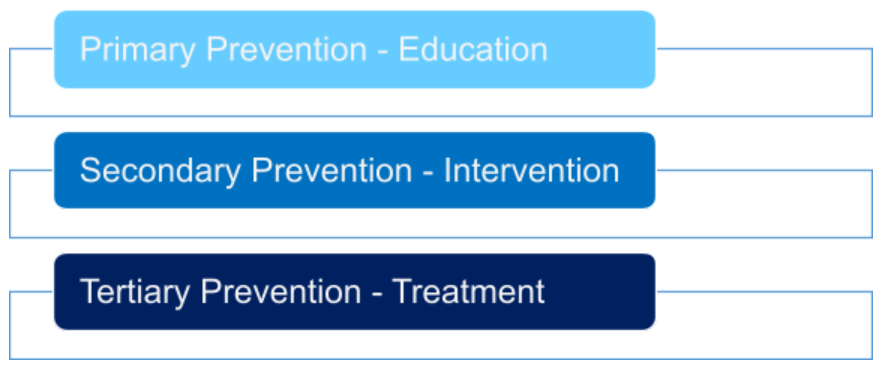
Primary Prevention – Education
- targets the general population
- prevent initiation of substance use or delay the age of onset
- reduces supply of drugs available
- reduces the demand for drugs
- reduce risk factors and increases protective factors for drug use initiation
- directed mostly at younger children and adolescents
The main goal of the primary level of prevention is to prevent substance misuse from occurring and to prevent the initiation of substance use. If individuals do not begin to experiment with substances until an older age, they are less likely to experience substance misuse. The risk of developing dependence or misuse is greater for individuals who initiate use in adolescence or early adolescence than for those who initiate use during adulthood. Evidence of this increase risk highlights the need for early prevention, screening, and timely intervention among youth (SAMHSA, 2014).
Secondary Prevention – Intervention
- targets individuals in the early stages of substance use
- prevents use becoming a problem and limit the damage to the individual
- targets risk groups, experimenters, and early misuse populations to stem the progression of misuse behaviors
Secondary prevention is designed to target individuals who are at high risk and may already be engaging in risky behaviors. It is similar to “early intervention” as the goal is to prevent the problem from progressing or getting worse, and to uncover potentially harmful substance use prior to the onset of major symptoms or problems.
Tertiary Prevention – Treatment
- ends dependence and minimize problems resulting from misuse
- enables the individual to achieve and maintain an improved level of functioning and health
Tertiary prevention is intervention at an advanced state of drug misuse. It is often called rehabilitation and/or relapse prevention as the individual is already engaging in problematic using behaviors. This level is synonymous with substance misuse treatment. Tertiary prevention treats the medical consequences of substance misuse and facilitates entry into treatment so further disability and impairment is minimized. The goal of the final level of prevention is to end dependence and minimize problems resulting from use and misuse (NIDA, Preventing drug use among children and adolescents, 2020).
Critical Thinking
Why do you think that the primary level of substance-misuse prevention is often seen as the best strategy to control substance misuse? Why should schools and programs focus on this level more, rather than on the secondary or tertiary levels of prevention?
Image 8.8 – Stethoscope
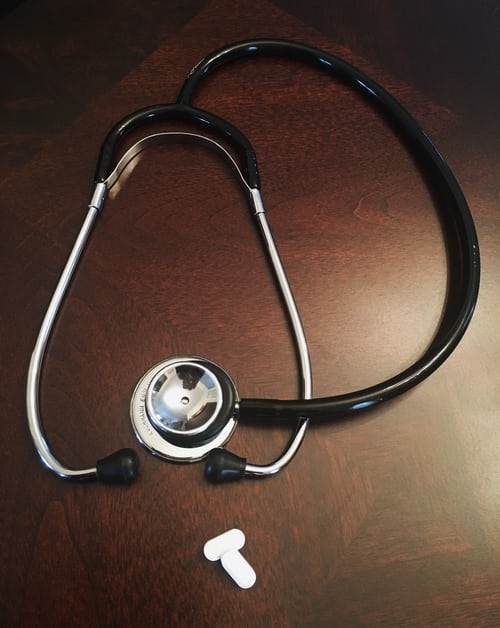
Treatment
from addiction is not a linear process. Similar to prevention models, effective treatment models are evidence-based and incorporate approaches that address the individual’s needs on multiple levels. It is also important to note that relapse is often a part of the recovery process.
Principles of Effective Treatment
Based on scientific research since the mid-1970s, the following key principles should form the basis of any effective treatment program:
- Addiction is a complex but treatable disease that affects brain function and behavior.
- No single treatment is right for everyone.
- People need to have quick access to treatment.
- Effective treatment addresses all of the patient’s needs, not just his or her drug use.
- Staying in treatment long enough is critical.
- Counseling and other behavioral therapies are the most commonly used forms of treatment.
- Medications are often an important part of treatment, especially when combined with behavioral therapies.
- Treatment plans must be reviewed often and modified to fit the patient’s changing needs.
- Treatment should address other possible mental disorders.
- Medically assisted detoxification is only the first stage of treatment.
- Treatment doesn’t need to be voluntary to be effective.
- Drug use during treatment must be monitored continuously.
- Treatment programs should test patients for HIV/AIDS, hepatitis B and C, tuberculosis, and other infectious diseases as well as teach them about steps they can take to reduce their risk of these illnesses (NIDA, Treatment approaches for drug addiction drugFacts, 2019)
Evidence-Based Approaches to Treating Substance-Use Disorders
The National Institute on Drug Abuse lists several options available for the treatment of substance-use disorders:
- behavioral counseling
- medication
- medical devices and applications used to treat symptoms or deliver skills training
- evaluation and treatment for co-occurring mental health issues such as depression and anxiety
- long-term follow-up to prevent relapse
There is no single treatment model that works for all. The approach chosen should consider the substance involved and the characteristics of the individual affected. The treatment program should be tailored to the individual and the most effective models offer options for follow-up (NIDA, 2018).
Follow-up care often includes community- and/or family-based recovery support systems. Treatment should include medical services for any physical issue brought on by the sustained drug use as well as mental health services to address the psychological aspects of using behaviors.
Effective options for treatment fall into two categories: behavioral approaches and pharmacotherapies.
Behavioral Treatment Approaches
There are several examples of behavioral approaches used throughout substance-misuse treatment. A few of those examples have been listed below. These types of models are the most commonly used and seek to provide the individual with tools to modify attitudes and behaviors related to their use by looking at their reasons and motivation to change. Behavioral treatment models provide the individual with skills necessary to handle stressors that may trigger substance use. This approach works to help the individual identify and address their (people, places, or events) associated with using behavior (NIDA, 2018).
Behavioral models often include individual, family, or group sessions. These models seek to provide incentives for remaining abstinent by replacing substance-using activities with more constructive and often pro-social activities. Some examples of these types of approaches include:
- Cognitive-Behavioral Therapy (CBT): involves efforts to change thinking patterns and helps patients recognize, avoid, and cope with the situations in which they are most likely to use drugs
- Community Reinforcement Approach (CRA): assists and encourages individuals to adopt a pleasurable and healthy lifestyle that is more rewarding than one using alcohol or drugs
- Motivational Enhancement Therapy (MET): uses positive reinforcement to encourage abstinence from drugs and often incorporates motivational interviewing techniques
- Twelve-step Therapy (Alcoholics Anonymous [AA], Narcotics Anonymous [NA], Cocaine Anonymous [CA], Heroin Anonymous [HA]): promotes abstinence by increasing the likelihood of a person misusing substances becoming affiliated with and actively involved in 12-step self-help groups
- The Matrix Model (Stimulants): mainly uses a group-session framework to engage people misusing stimulants (e.g., methamphetamine and cocaine) in treatment and help them achieve abstinence
Pharmacotherapies
Pharmacotherapy, or the treatment of a disorder or disease with medication, is often used in conjunction with behavioral therapy. These medications are used to assist with withdrawal symptoms and to help reduce drug cravings. Additionally, there are medications available for substance use treatment that work to block the effect of alcohol and other drugs and thus work to prevent relapse. Behavioral approaches in combination with pharmacotherapy can amplify the effects of medications. These different approaches work together to teach individuals coping skills they can practice in treatment, social, and work settings and how to recognize and avoid high-risk situations for relapse. Behavioral and pharmacological treatments are thought to operate by different but complementary, mechanisms that can have additive effects.
Particular medications or therapies treat addictions to specific substances:
Opioid Addiction
- methadone
Nicotine Addiction
- nicotine replacement therapy (NRT)
- bupropion (Zyban®)
- varenicline (Chantix®)
Alcohol Addiction
- naltrexone
- acamprosate
- disulfiram
- topiramate
Check Your Knowledge
Image 8.9 – Signs on Fence: Don’t Give Up; You Are Not Alone; You Matter
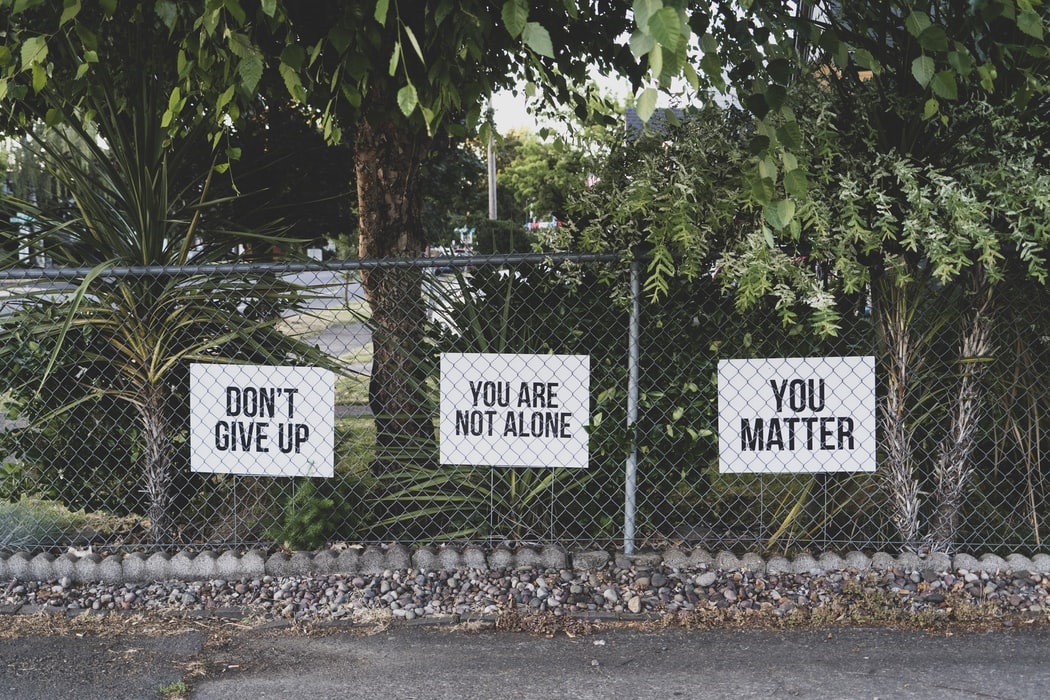
Types of addiction treatment settings
There are several ways that individuals can access behavioral treatment. Many models exist and should be tailored to the strengths and needs of the individual (NIDA, 2018).
Long-Term Residential Treatment
Long-term residential treatment facilities provide 24-hour care. Residential treatment models often follow the idea of a therapeutic community (TC), offering 6 -and 12- month length of stay in a non-hospital setting. TCs focus on the “resocialization” of the individual and use the program’s entire community—including other residents, staff, and the social context—as active components of treatment. Treatment is highly structured, with activities designed to help residents examine damaging beliefs, self-concepts, and destructive patterns of behavior and adopt new, more harmonious and constructive ways to interact with others. Many TCs offer comprehensive services, which can include employment training and other support services, onsite. Research shows that TCs can be modified to treat individuals with special needs, including adolescents, women, homeless individuals, people with severe mental disorders, and individuals in the criminal justice system (NIDA, 2018).
Short-Term Residential Treatment
In contrast, short-term residential programs offer a shorter length, anywhere from a 3- to 6-week length of stay and utilize a modified 12-step approach. These programs were originally designed to treat alcohol problems, but during the cocaine epidemic of the mid-1980s, many began to treat other types of substance-use disorders.
Following a stay in either long-term or short-term residential treatment programs, it is important for individuals to remain engaged in outpatient treatment programs and/or an aftercare program. These programs help to reduce the risk of relapse once a patient leaves the residential setting and is back in the community and home environment (NIDA, 2018).
Outpatient Treatment Programs
Outpatient treatment varies in the types and intensity of services offered. Such treatment typically costs less than residential or inpatient treatment and often is more suitable for people with jobs or extensive social support. Other outpatient models, such as intensive day treatment, can be comparable to residential programs in services and effectiveness, depending on the individual patient’s characteristics and needs. In many outpatient programs, group counseling can be a major component. Some outpatient programs are also designed to treat patients with medical problems in addition to their substance use disorders (NIDA, 2018).
Individualized Drug Counseling
Individualized drug counseling not only focuses on reducing or stopping the substance use but it also addresses other related and affected areas of the individual’s life such as employment, illegal activity, and family/social relations. Through its emphasis on short-term behavioral goals, individualized counseling helps the patient develop coping strategies and tools to abstain from substance use and maintain abstinence. The addiction counselor often encourages 12-step participation (at least one or two times per week) and makes referrals for needed supplemental services, such as medical, psychiatric, and employment (NIDA, 2018).
Group Counseling
Many therapeutic settings use group therapy to capitalize on the social reinforcement offered by peer discussion and to help promote substance-free lifestyles. Research shows that when group therapy is offered in conjunction with individualized drug counseling or incorporates the principles of cognitive-behavioral therapy then positive outcomes are likely achieved. Current research seeks to test group therapy sessions and study how to make those same sessions more community-friendly (NIDA, 2018).
Conclusion
The cost of substance use and misuse could be offset by a nationwide implementation of effective prevention policies and programs. Utilizing SAMHSA’s Strategic Prevention Framework provides a structure for creating and implementing effective prevention models. Communities should consider prevention programs based on the needs and characteristics of their intended populations. Additionally, treatment for substance-use disorders exists in several forms. Behavioral counseling and medications have been shown to be highly effective and can be used to change the course of addiction in adolescents and adults alike. Similarly to prevention methods, substance misuse treatment also lessens the cost and burden to society. Treatment for substance misuse costs less than incarcerating individuals for drug offenses; less is spent on healthcare as well. In addition, treatment reverses many negative aspects associated with misuse, such as the loss of worker productivity, accidents related to impairment, and overdose deaths.
Supplemental Resources
Buddy, T. (2020, September 15). How Drug Use Affects Our Society. Verywell Mind. Retrieved July 20, 2021, from https://verywellmind.com/what-are-the-costs-of-drug-abuse-to-society-63037
Meyers, R. J., Roozen, H. G., & Smith, J. E. (2011). The community reinforcement approach: An update of the evidence. Alcohol Research & Health: The Journal of the National Institute on Alcohol Abuse and Alcoholism, 33(4), 380–388. https://pubmed.ncbi.nlm.nih.gov/23580022/
National Institute on Drug Abuse. (2014, January). Principles of adolescent substance use disorder treatment: A research-based guide. National Institutes of Health, U.S. Department of Health and Human Services. Retrieved July 20, 2021, from https://nida.nih.gov/publications/principles-adolescent-substance-use-disorder-treatment-research-based-guide/
National Institute on Drug Abuse. (2020, July 10). Drugs, brains, and behavior: The science of addiction. National Institutes of Health, U.S. Department of Health and Human Services. Retrieved on July 30, 2021, from https://nida.nih.gov/publications/drugs-brains-behavior-science-addiction/preventing-drug-misuse-addiction-best-strategy
References
Botvin, G. J. (1986). Substance abuse prevention research: Recent developments and future directions. Journal of School Health, 56(9), 369-374. https://doi.org/10.1111/j.1746-1561.1986.tb05775.x
National Center for Injury Prevention and Control, Division of Violence Prevention. (2021, January 21). The social-ecological model: A framework for prevention. Centers for Disease Control and Prevention. Retrieved July 30, 2021, from https://www.cdc.gov/violenceprevention/about/social-ecologicalmodel.html
Landmark Recovery. (2020, May 18). Why the D.A.R.E. program failed. Retrieved July 25, 2021, Retrieved from https://landmarkrecovery.com/why-the-dare-program-failed
National Institute on Drug Abuse. (2018, January). Principles of drug addiction treatment: A research-based guide (3rd ed.). National Institutes of Health, U.S. Department of Health and Human Services. Retrieved on July 20, 2021, from https://nida.nih.gov/publications/principles-drug-addiction-treatment-research-based-guide-third-edition/preface
National Institute on Drug Abuse. (2019, January 17). Treatment approaches for drug addiction drugFacts. National Institutes of Health, U.S. Department of Health and Human Services. Retrieved July 30, 2021, from https://nida.nih.gov/publications/drugfacts/treatment-approaches-drug-addiction
National Institute on Drug Abuse. (2020, June 10). Preventing drug use among children and adolescents (in brief). National Institutes of Health, U.S. Department of Health and Human Services. Retrieved on July 30, 2021, from https://nida.nih.gov/publications/preventing-drug-use-among-children-adolescents/prevention-principles
Office of National Drug Control Policy. (n.d.). How illicit drug use affects business and the economy. Executive Office of the President. Retrieved July 21, 2021, from https://obamawhitehouse.archives.gov/ondcp/ondcp-fact-sheets/how-illicit-drug-use-affects-business-and-the-economy
Substance Abuse and Mental Health Services Administration. (2019, June). A guide to SAMHSA’s strategic prevention framework. U.S. Department Health and Human Services. https://www.samhsa.gov/sites/default/files/20190620-samhsa-strategic-prevention-framework-guide.pdf
Substance Abuse and Mental Health Services Administration. (2019, August). Key substance use and mental health indicators in the United States: Results from the 2018 National Survey on Drug Use and Health (HHS Publication No. PEP19-5068, NSDUH Series H-54). Center for Behavioral Health Statistics and Quality. Retrieved July 20, 2021, from https://www.samhsa.gov/data/sites/default/files/cbhsq-reports/NSDUHNationalFindingsReport2018/NSDUHNationalFindingsReport2018.pdf
Substance Abuse and Mental Health Services Administration, Center for Behavioral Health Statistics and Quality. (2014, July 17). The TEDS report: Age of substance use initiation among treatment admissions aged 18 to 30. U.S. Department of Health and Human Services. https://www.samhsa.gov/data/sites/default/files/WebFiles_TEDS_SR142_AgeatInit_07-10-14/TEDS-SR142-AgeatInit-2014.htm
The use of illegal drugs or the use of prescription or over-the-counter drugs or alcohol for purposes other than those for which they are meant to be used, or in excessive amounts.
Any chemical agent (natural or artificial) that affects the mind and is abusively used: alcohol, Illegal street drugs, addictive prescription and over the counter drugs, other mind altering substances, and tobacco
Any activity designed to avoid substance misuse and reduce its health and social consequences
A substance is often taken in larger amounts or over a longer period than intended. There is a persistent desire or unsuccessful efforts to cut down or control substance use. A great deal of time is spent in activities necessary to obtain the substance, use the substance, or recover from its effects.
Recovery is a process of change through which individuals improve their health and wellness, live self-directed lives, and strive to reach their full potential.
Symptoms that can occur after long-term use of a drug is reduced or stopped; these symptoms occur if tolerance to a substance has occurred, and vary according to substance. Withdrawal symptoms can include negative emotions such as stress, anxiety, or depression, as well as physical effects such as nausea, vomiting, muscle aches, and cramping, among others. Withdrawal symptoms often lead a person to use the substance again.
A person, place, or event that may cause your brain to flashback to the days when you were using. Triggers are the most common obstacles that can deter an individual from their recovery and sometimes lead to relapse.



